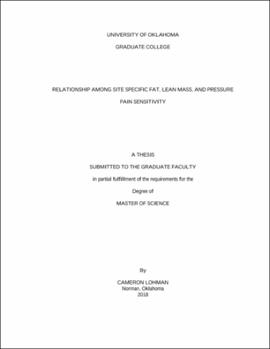| dc.description.abstract | Pain is an unpleasant sensory or emotional experience associated with tissue damage or the potential for tissue damage. Over the years, research has studied the relationship between pain and body composition (BC). PURPOSE: The purposes of this study were to investigate if there are any site specific differences in pressure pain threshold (PPT), if lean and fat mass correlate with PPT values in any way, and if the magnitude of a conditioned pain modulation (CPM) or exercise-induced hypoalgesia (EIH) is affected by BC. METHODS: 30 female and 26 male participants 3 experimental visits. BC via DXA scans and muscle/fat thickness at the specific sites were assessed on the first visit. During the first visit, participants were also familiarized to the PPT protocol. The second visit consisted of a baseline PPT measurement followed by a CPM where participants placed their feet in an ice bath for 1 min. Once the CPM protocol was completed, PPTs were measured immediately after. Baseline PPTs were measured again for the third visit, followed by an EIH protocol. To produce and EIH response, participants held 25% of their maximal isometric knee extension till failure. PPTs were assessed immediately after exercise failure. A Spearman correlation coefficients were determined between BC values and baseline PPTs. Independent t-test was used to determine any gender differences, and a mixed factorial ANOVA was ran for CPM and EIH assessments. RESULTS: PPTs from the left forearm (LA) had no significant correlations for total body fat (p = 0.85), body fat percentage (p = 0.20), fat percentage within the limb (p = 0.73), fat mass within the limb (p = 0.08), fat thickness at the measured site (p = 0.59), or skinfold measurements at the site (p = 0.71). No significant relationship was found in the right forearm (RA) [total body fat (p = 0.81), body fat percentage (p = 0.24), fat percentage within the limb (p = 0.52), fat mass within the limb (p = 0.83), fat thickness at the measured site (p = 0.63), or skin fold measurements (p = 0.62)] or the non-dominant leg (NDL) [total body fat (p = 0.07), body fat percentage (p = 0.32), fat mass within the limb (p = 0.33), fat thickness at the site (p = 0.33), or skin fold measurements (p = 0.50).The dominant limb’s (DL) PPT did show a significant negative correlation with fat percentage within the limb (p = 0.03). The DL did not correlate with total body fat (p = 0.90), body fat percentage (p = 0.104), fat mass within the limb (p = 0.42), fat thickness at the measured site (p=0.08), or skinfold measurements (p = 0.29). LA and NDL had significant correlations with total bone free lean mass (LA: p = 0.02, NDL: p ≤ 0.001), bone free lean mass at the limb (LA: p = 0.02, NDL: p ≤ 0.001), and muscle thickness (LA: p = 0.03, NDL: p = 0.026). The DL had significant correlations for total bone free lean mass (p ≤ 0.001) and bone free lean mass at the limb (p ≤ 0.001), but not for muscle thickness (p = 0.13). The RA showed significant correlations with bone free lean mass at the limb (p = 0.04), but not total bone free lean mass (p = 0.09) or muscle thickness (p = 0.26). There were no significant correlations between any of the BC measurements and the magnitude of CPM response (p > 0.05). The EIH response significantly increased PPTs for all of the four measured sites (p ≤ 0.001). The EIH responses did not correlate with any of the taken BC measurements for the LA or the DL (p ≥ 0.05). The RA had a significant correlation with total body fat (p = 0.04), fat mass within the limb (p = 0.03), and skinfold measurements (p = 0.03); However, all other RA BC measurement did not (p ≥ 0.05). No measures of BC correlated with the EIH response for the NDL (p ≥ 0.10). The EIH responses for the NDL did not correlate with total bone free lean mass or bone free lean mass with in the limb (p ≥ 0.05). The results did show that the NDL muscle thickness was negatively correlated with the EIH response (p = 0.04). CONCLUSION: PPTs positively correlated with bone free lean mass and not fat mass, suggesting that bone free lean mass plays a role in individuals PPTs values. The CPM response showed no relationship with BC. Results did suggest a potential relationship between the EIH response and BC; however, further investigation is needed to determine if a relationship exists. | en_US |
